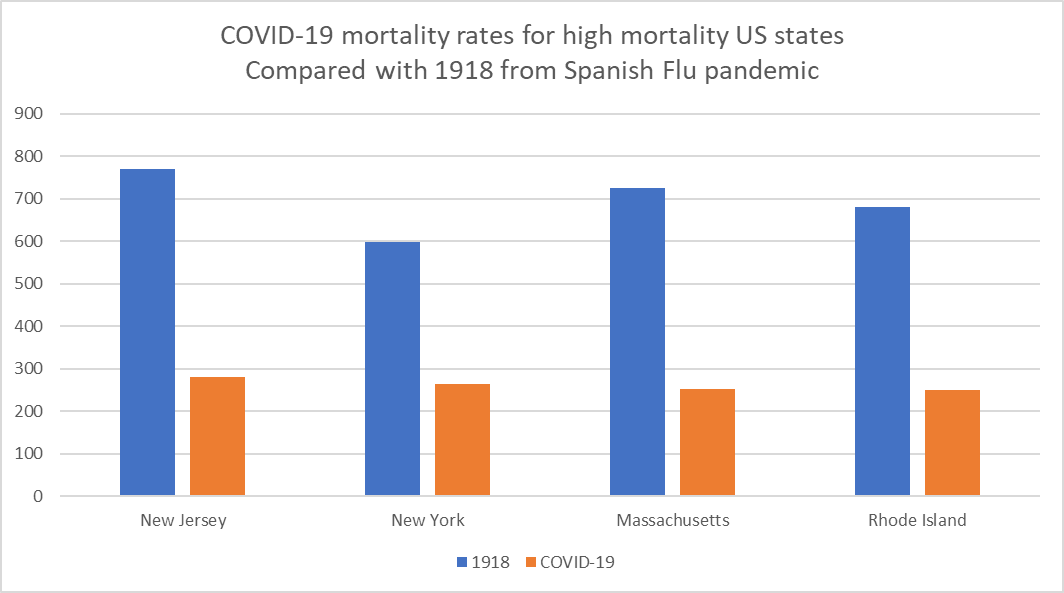Deadly parallels
Ever since the unhappy arrival of the SARS-COV-2 virus, COVID-19 and influenza have been compared for a multiplicity of reasons. I'm guilty of it myself: around the time of the first COVID-19 lockdown, a friend challenged me on why governments would consider the imposition of such extraordinary measures. My argument was simply that authorities presumably feared COVID-19 could become the next Spanish Flu. Of course, making such statements at that time might have been considered overreach, but I cited that once-in-a-century high-fatality pandemic disaster to illustrate why such strong measures could be considered both reasonable and warranted. It was odd then to find that influenza comparisons were just as easily applied for the opposite purpose: political leaders in both Brazil and the USA compared the present pandemic to "the flu" as a reassurance, seemingly to justify less stringent intervention. Perhaps nothing reframes an existential threat quite like the passing of one hundred years.
Of course, two things are true: firstly, our societies do live with seasonal influenza, and barring a panic every decade or two when somebody tags an animal species or territory to the start of an outbreak, we do our best to avoid thinking much about it; secondly, COVID-19 has proven decidely unlike seasonal influenza. Specifically, the same public-health measures that barely contain COVID-19 appear to nearly eliminate the incidence of seasonal influenza. Indeed, if COVID-19 had behaved like influenza we'd have been on firmer ground: despite the World Health Organisation including a placeholder "Disease X" on their priority disease list to ensure preparations considered novel pathogens, this proved easier said than done. In a UK context we found when that novel pathogen arose, our early planning documents contained a large number of literal unknowns.
When comparing events, casual rhetoric can only take us so far, and a worthwhile comparison must be grounded in data. Stephen has already shown that UK experience of the 1918 pandemic and COVID-19 bears comparison in a number of concrete aspects. Such an examination might also be made in the USA:
"In the United States, a quarter of the population caught the virus, 675,000 died, and life expectancy dropped by 12 years. With no vaccine to protect against the virus, people were urged to isolate, quarantine, practice good personal hygiene, and limit social interaction."
The above quotation provides some hard numbers. A quarter of the US population in 1918 was around 26 million people of whom 675,000 were lost to the virus. Today the ongoing viral pandemic in the USA has passed 31 million cases, with 564,000 deaths. Clearly the US population has grown significantly, and the current case numbers do not represent a quarter of the current US population of 332 million, but neither do they reflect infection counts. For that we can look at the CDC Disease Burden estimates from January 2021. The current estimate of 81 million infections is indeed around a quarter of the US population, so in terms of contagion, the ongoing COVID-19 outbreak has already reached the scale of the 1918 Pandemic in the US. Mortality rates, however, show the small mercy that COVID-19 in the US has been (with the current prevailing variants at least) less deadly than the Spanish Flu. Figure 1 shows those US States with highest COVID-19 mortality rates alongside their mortality rates for the peak year of the Spanish Flu:
Figure 1. High COVID-19 mortality US states versus 1918 (rates per 100,000). Source: Data from Statista here and here.

We can see that Spanish Flu exhibited mortality rates more than double those suffered in the highest mortality rate US states during the COVID-19 outbreak. As Stephen mentioned, the Spanish Flu had an unusual and deadly characteristic: while most epidemics show a U-shaped mortality impact, with the vulnerable youngest and oldest being most likely to die, the 1918 influenza outbreak exhibited a W-shape, with a peak in the age range 20-40. In other words, the most socially and economically active young adults, highly likely to catch a respiratory infection, were also highly likely to succumb to it. We now know to our cost that Spanish Flu and COVID-19 are validly comparable, but COVID-19 has not (in current variants) quite matched that influenza's peculiar and deadly virulence.
References:
UK Government (2021) Influenza vs COVID planning assumptions, 10 February 2020, Scientific Advisory Group for Emergencies (SAGE).
Olsen, S.J., et al (2020) Decreased Influenza Activity During the COVID-19 Pandemic - United States, Australia, Chile, and South Africa, 2020, MMWR Morb Mortal Wkly Rep, 2020 Sep 18;69(37):1305-1309. doi: 10.15585/mmwr.mm6937a6
Gross, P., et al (2001) Observations on Mortality during the 1918 Influenza Pandemic, Clinical Infection Diseases Volume 33, Issue 8 https://doi.org/10.1086/322662


Add new comment